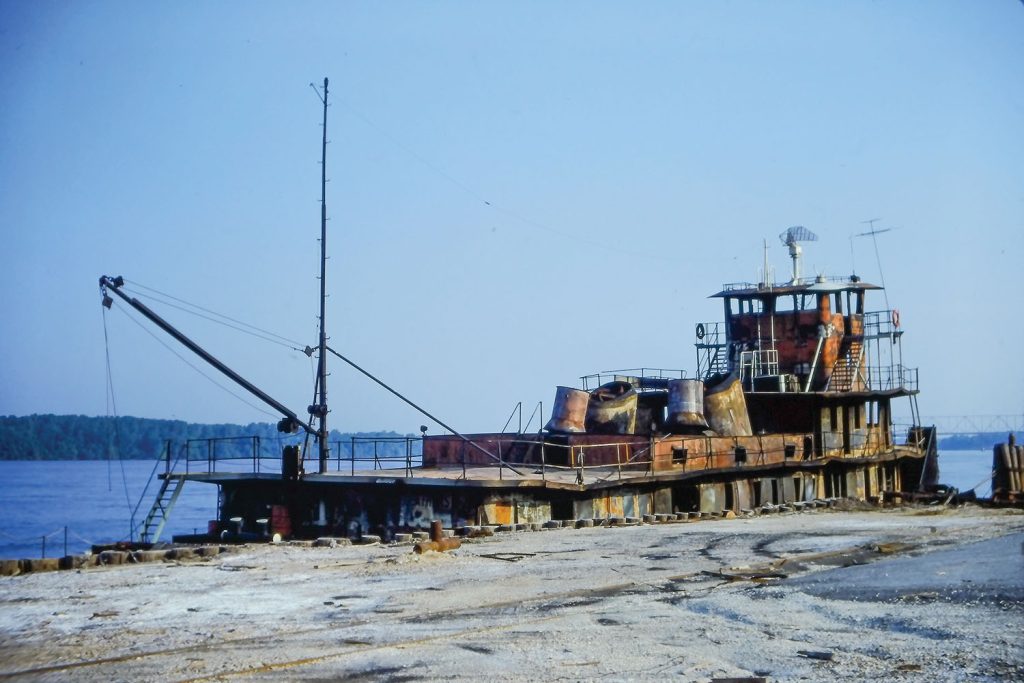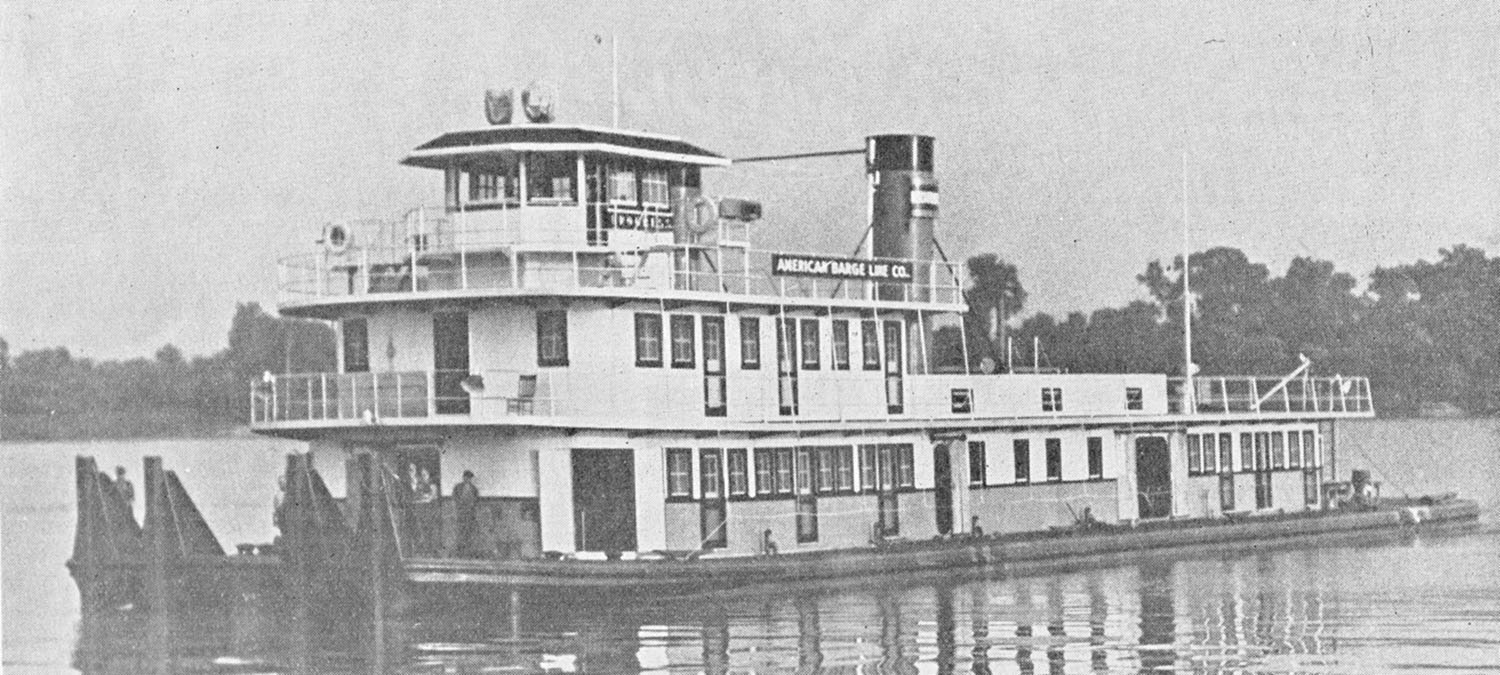Capt. Mike Herschler sent out some photos to a group of friends and river aficionados last week. These shots depicted a burned towboat, which just happened to be one that was on a short list for this column.
American Barge Line (ABL), forerunner of present-day ACBL, was formed in the late 1920s when W.C Kelly teamed with Andrew and Patrick Calhoun, pooled resources and created the new concern. At the time, some of the most modern diesel-powered towboats were in this fleet, including the twin-prop sister boats Geo. T. Price and W.A. Shepard, each rated at 720 hp., and the twin-sternwheel Duncan Bruce that had two engines totaling 750 hp. The small steam sternwheel Dixie was also a part of the early fleet of ABL.
As with most other major barge lines, ABL would still turn to steam power for heavy towing in those early days. At different times, steam sternwheel towboats such as the Iron City (Way’s T1199), James B. Ostrander (T1321) and Katie Lyons (T1500) were working on charter to ABL. They also purchased some steam towboats, including the Plymouth (T2061 – wooden hull dating to 1899) and Inland (T1181). They acquired the newer Walter A. Windsor, which had been built by Marietta Manufacturing in 1929, naming it Robert F. Brandt (T2172). Their oddest acquisition was the steam sidewheel ferry Pioneer (T2055), a huge craft built for operation on the East Coast that measured 240 by 47 feet. ABL converted it to towing and utilized it on the Lower Mississippi as a steam sidewheeler until 1936, when it was converted to twin-screw diesel.
ABL continued to grow and expand, and in early 1939, the pages of The Waterways Journal began reporting that ABL was having two new diesel prop towboats constructed by Treadwell Construction Company, Midland, Pa. (Midland Barge Company was an affiliate.) Midland had built the diesel-powered Franklin D. Roosevelt and Tom Sawyer for the Inland Waterways Corporation (Federal) in 1933, and the two ABL boats would be identical in hull size to these.
The Louisville News column of the WJ stated later that the hull of the first boat had been completed at Midland and was towed to Jeffersonville, Ind., where the remainder of the new boat would be finished by ABL. A photo of the new boat, named Progress, appeared in the October 14, 1939, WJ, along with commentary below that described the vessel It had a hull that was 160 by 40 feet, and it was powered by a pair of Cooper-Bessemer LT-8 engines totaling 2,000 hp. at 300 rpm.
The commentary said that the boat had “made her maiden trip late in July and has proven entirely satisfactory.” The crew quarters were described as “roomy and well ventilated,” and the pilothouse had “double steering levers for the main and backing rudders, but no pilot wheel,” an exclusion still important enough to mention in 1939. The last of the description says that the hull of the boat was built by Treadwell, but that the boat was completed at “the American Barge Line plants at Louisville and Jeffersonville.” Editions of the Inland River Record would later state that it had been completed at Jeffersonville Boat & Machine Company (Jeffboat), which ABL had organized in 1938.
The Progress and the sister vessel, which had been named Patriot, were featured in the “Annual New Year’s Number” December 30, 1939, issue of the WJ, with J. Mack Gamble stating that they were “the largest addition of the year in total horsepower,” and that they were among the most powerful twin-screw vessels on the rivers. Gamble also noted that these diesel boats had an interesting feature. They had steam-operated auxiliaries, and the boiler for them was heated by the main engine exhaust. Photos at the time clearly show a steam whistle mounted forward on the port smokestack.
In 1949, ABL sold the Progress to Martin Oil Service Inc., Chicago, which renamed it Marco. Martin removed the steam equipment and, following a fire in 1952, the crew quarters and pilothouse were rebuilt and “modernized,” according to the IRR. In June 1955, it was sold to G.B. Zigler Company, Jennings, La., and renamed Z-Fourteen. In 1958, it was repowered with a pair of GM 16-278A engines that developed 3,200 hp. at 744 rpm. In 1965, it was sold to Republic Towing Company, Greenville, Miss., which completely rebuilt the boat and repowered it with EMD 16-567C engines, still 3,200 hp. Following this rebuilding it was named Winston Churchill.
The boat was sold for a final time, in 1968 to Big W Towing Company, Greenville, which renamed it Chip Weathers. In the spring of 1970, it was towing on the Upper Mississippi River. It had locked down through Lock 19 at Keokuk and was proceeding downstream when fire was discovered onboard. The boat and tow landed in the vicinity of Alexandria, Mo., and, according to Capt. Herschler, in an isolated area with no firefighting support nearby. The crew and nearby vessels did what they could, but the boat wound up a total loss. Photos taken by Herschler after the incident show a gutted vessel, with the steel of decks and bulkheads buckled and the twin stacks canted in toward one another.

Caption for top photo: The Progress as it appeared when new in the October 14, 1939, Waterways Journal. (David Smith collection)
Capt. David Smith can be contacted at davidsmith1955obc@gmail.com.




